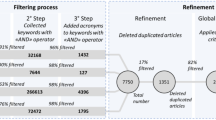Abstract
Computer-aided process planning has shown its great importance in computer integrated manufacturing systems. Dimensioning and tolerancing plays a key role in process planning since the final workpiece must ensure conformance with the dimensions in its blueprint. This paper proposes a simple, efficient approach to derive working dimensions for process planning, based on the tolerance chart technique. The paper first reviews briefly some approaches previously presented, such as the mathematical linear equation approach and the graph tracing approach, it then proposes the backward derivation approach. By setting up the origin of a coordinate system at the left-most surface in a blueprint (B/P), the approach first determines the distances from all the B/P surfaces to the origin by use of the B/P dimensions. Then by updating these dimensions, the final working dimensions are calculated backwards by a simple arithmetical equation.
Similar content being viewed by others
References
L. Alting, and H. Zhang, “Computer aided process planning: the state-of-the-art survey”,International Journal of Production Research,27(4), pp. 553–585, April 1989.
John L. Gadzale,Dimensional Control in Manufacturing, McGraw-Hill Book Company, 1959.
R. S. Ahluwalia and A. V. Karolin, “CATC — a computer aided tolerance control system”,Journal of Manufacturing Systems,3(2), pp. 153–160, 1984.
T. Xiaoqing, and B. J. Davies, “Computer aided dimensional planning”,International Journal of Production Research,26(2), pp. 283–297, February 1988.
P. Ji, “A tree approach for tolerance charting”,International Journal of Production Research,31(5), pp. 1023–1033, May 1993.
K. Whybrew, G. A. Britton, D. F. Robinson and Y. Sersuti-Anuwat, “A graph-theoretic approach to tolerance charting”,International Journal of Advanced Manufacturing Technology,5(2), pp. 175–183, 1990.
P. Ji, “A linear programming model for tolerance assignment in a tolerance chart”,International Journal of Production Research,31(3), pp. 739–751, March 1993.
S. A. Irani, R. O. Mittal and E. A. Lehtihet, “Tolerance chart optimization”,International Journal of Production Research,27(9), pp. 1531–1552, September 1989.
R. O. Mittal, S. A. Irani and E. A. Lehtihet, “Tolerance control in the machining of discrete components”,Journal of Manufacturing Systems,9(3), pp. 233–246, 1990.
P. Ji, “An automatic tolerance assignment approach for tolerance charting”,International Journal of Advanced Manufacturing Technology,9(6), pp. 362–368, 1994.
Author information
Authors and Affiliations
Rights and permissions
About this article
Cite this article
Ji, P. Determining dimensions for process planning: A backward derivation approach. Int J Adv Manuf Technol 11, 52–58 (1996). https://doi.org/10.1007/BF01177184
Issue Date:
DOI: https://doi.org/10.1007/BF01177184




